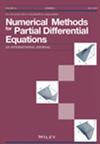三维流体-二维板相互作用系统有限元近似的分区法
IF 1.7
3区 数学
Q1 MATHEMATICS, APPLIED
引用次数: 0
摘要
我们考虑了流固耦合(FSI)系统的有限元近似,该系统由三维斯托克斯流和二维四阶欧拉-伯努利或基尔霍夫板组成。这些抛物和双曲偏微分方程(PDE)的相互作用发生在边界界面上,而边界界面假定是固定的。板动力学的垂直位移在边界的平坦部分发生变化,耦合条件通过板和流体流的匹配速度以及压力的 Dirichlet 边界迹线实现。压力项也是一种耦合剂,因为它是平坦弹性板域上的一个强制项。我们在这项工作中的主要重点是生成有关 FSI 模型近似解的一些数值结果。为此,我们提出了一种数值算法,通过有效的解耦方法依次求解流体和平板子系统。为了说明所提方法的性能,我们给出了测试问题的数值结果。本文章由计算机程序翻译,如有差异,请以英文原文为准。
Partitioning method for the finite element approximation of a 3D fluid‐2D plate interaction system
We consider the finite element approximation of a coupled fluid‐structure interaction (FSI) system, which comprises a three‐dimensional (3D) Stokes flow and a two‐dimensional (2D) fourth‐order Euler–Bernoulli or Kirchhoff plate. The interaction of these parabolic and hyperbolic partial differential equations (PDE) occurs at the boundary interface which is assumed to be fixed. The vertical displacement of the plate dynamics evolves on the flat portion of the boundary where the coupling conditions are implemented via the matching velocities of the plate and fluid flow, as well as the Dirichlet boundary trace of the pressure. This pressure term also acts as a coupling agent, since it appears as a forcing term on the flat, elastic plate domain. Our main focus in this work is to generate some numerical results concerning the approximate solutions to the FSI model. For this, we propose a numerical algorithm that sequentially solves the fluid and plate subsystems through an effective decoupling approach. Numerical results of test problems are presented to illustrate the performance of the proposed method.
求助全文
通过发布文献求助,成功后即可免费获取论文全文。
去求助
来源期刊
CiteScore
7.20
自引率
2.60%
发文量
81
审稿时长
9 months
期刊介绍:
An international journal that aims to cover research into the development and analysis of new methods for the numerical solution of partial differential equations, it is intended that it be readily readable by and directed to a broad spectrum of researchers into numerical methods for partial differential equations throughout science and engineering. The numerical methods and techniques themselves are emphasized rather than the specific applications. The Journal seeks to be interdisciplinary, while retaining the common thread of applied numerical analysis.

 求助内容:
求助内容: 应助结果提醒方式:
应助结果提醒方式:


